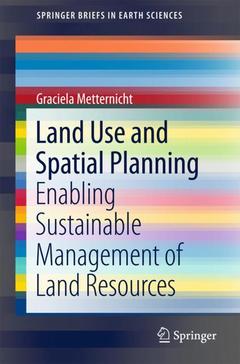Description
Land Use and Spatial Planning , 1st ed. 2018
Enabling Sustainable Management of Land Resources
SpringerBriefs in Earth Sciences Series
Author: Metternicht Graciela
Language: English
Subjects for Land Use and Spatial Planning :
68.56 €
In Print (Delivery period: 15 days).
Add to cartSupport: Print on demand
Description
/li>Contents
/li>Biography
/li>Comment
/li>
This bookreconciles competing and sometimes contradictory forms of land use, while also promoting sustainable land use options. It highlights land use planning, spatial planning, territorial (or regional) planning, and ecosystem-based or environmental land use planning as tools that strengthen land governance. Further, it demonstrates how to use these types of land-use planning to improve economic opportunities based on sustainable management of land resources, and to develop land use options that strike a balance between conservation and development objectives.
Competition for land is increasing as demand for multiple land uses and ecosystem services rises. Food security issues, renewable energy and emerging carbon markets are creating pressures for the conversion of agricultural land to other uses such as reforestation and biofuels. At the same time, there is a growing demand for land in connection with urbanization and recreation, mining, food production, and biodiversity conservation. Managing the increasing competition between these services, and balancing different stakeholders? interests, requires efficient allocation of land resources.
Outlines spatial and land use planning (LUP) approaches that promote sustainable land use and management
Identifies and defines principles of LUP for sustainable land use and management: multi-functionality of land, multi-stakeholder participation, and cross-sectoral involvement
Assesses approaches to spatial and LUP in terms of their ability to identify and promote sustainable land use options
Presents a broad range of case studies from different geographies, economies and scales (regional, national, local) to showcase effective LUP practices and policies in support of sustainable land use and management, analyzing and synthesizing opportunities, as well as their limitations
Discusses the use of LUP to pursue internationally agreed development goals: the sustainable development goals (SDGs) and the land degradation neutrality (LDN) target




